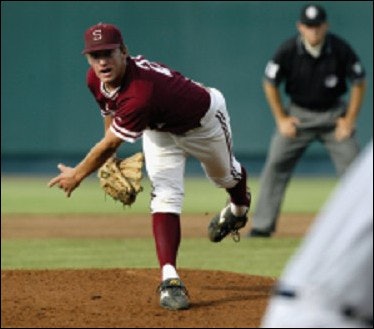Andrew Sanchez, severely injured by a line drive, may yet have a case

The typical baseball pitcher is approximately 52 feet away from home plate when he releases the ball, usually in an off-balance position with his glove down and his weight moving forward. In this position, if the ball is hit back at him, a pitcher has less than half a second to react. While this might seem to some to be simply "part of the game," others claim that the new generation of high tech, lightweight aluminum bats - which can send the ball rocketing back at more than 100 miles per hour - have unreasonably increased the risk a pitcher faces. For example, most experts believe that a pitcher needs approximately 0.4 seconds to react to a line drive and avoid being struck. With many new models of aluminum bats, however, tests have shown that the ball can travel 52 feet in 0.354 seconds.
Whether high-tech aluminum bats create an unreasonable risk was the issue in Sanchez v. Hillerich & Bradsby Co. [104 Cal. App. 4th 703; 128 Cal. Rptr. 2d 529 (2002)]. Andrew Sanchez, a pitcher for California State University, Northridge (CSUN), suffered serious head injuries when he was struck by a line drive off the bat of Dominic Correa during an April 1999 game. Correa, who was playing for the University of Southern California, was using an Air Attack 2, a newly designed hollow aluminum-alloy bat with a pressurized air bladder designed and manufactured by Hillerich & Bradsby Co. According to H&B, the Air Attack 2 was designed to substantially increase the speed at which the ball leaves the bat.
At the time that Sanchez was hurt, NCAA rules allowed the use of metal bats and the bat was made in compliance with NCAA standards. However, prior to the start of the 1999 season, the NCAA had notified athletic conferences under its umbrella, including the Pac-10, of the dangerous nature of the newer metal bats and of its decision to implement new rules to decrease the speed of the batted balls effective August 1, 1999. The Pac-10 implemented some of the proposed standards prior to the 1999 season, but still allowed schools to use the Air Attack 2 and other new lightweight aluminum bats.
As a result of his injuries, Sanchez filed a product-liability suit against H&B. In particular, Sanchez argued that the design and use of the Air Attack 2 significantly increased the risk that a pitcher would be hit by a line drive. In addition, Sanchez also filed suit against the NCAA and USC for negligence in allowing Correa to use the Air Attack 2, even after both parties knew that the bat unreasonably increased the risk of injury to pitchers.
In moving for summary judgment, H&B argued that:
1) It could not be negligent, since Sanchez could not establish causation as a matter of law;
2) The action was barred by the doctrines of primary assumption of risk and express assumption of risk; and
3) H&B was entitled to judgment because the bat was in compliance with rules established by the NCAA.
In support of its motion, H&B submitted testimony from various experts who claimed that getting hit by batted balls was one of the risks associated with pitching. In addition, the NCAA and the Pac-10 argued that under the doctrine of assumption of risk, Sanchez was barred from filing suit. In support of this claim, they pointed to a disclaimer form signed by Sanchez prior to the season acknowledging that his participation on the team carried a risk of injury, specifically including brain damage, and consenting to assume the risk of such an injury. The NCAA and the Pac-10 also argued that they owed no duty to Sanchez because at the time of the accident the baseball community was in significant disagreement over the risk of aluminum bats.
The trial court, in granting summary judgment, concluded that Sanchez would be unable to prove that his injuries resulted from the alleged increased risk to pitchers caused by the Air Attack 2. On appeal to the California Court of Appeals, Sanchez argued that primary assumption of risk was not applicable. Under this doctrine, in order for an individual to assume a risk, he or she must know of the risk and knowingly and voluntarily accept the risk. While Sanchez argued that he could not have known of the increased risk caused by the bat, he did elicit the testimony of the designer of the Air Attack 2, who stated that the bat substantially increased the risk of a pitcher being hit by what he termed a "comebacker." In addition, the designer stated that when he complained to H&B about the increased risk of injuries, his complaints were ignored and he was warned that he should not publicly discuss issues of safety.
Sanchez also submitted evidence that the ball that struck him was traveling between 101 and 107.8 miles per hour. Experts testified that at that speed, Sanchez would only have had between 0.32 to 0.37 seconds to avoid the ball. This was below the minimum reaction time (0.39 seconds) accepted by the NCAA and other organizations. As a result, these experts concluded, Sanchez's head injury was the direct result of the increased danger posed by the Air Attack 2.
In reversing the decision of the trial court, the appeals court ruled that when addressing the applicability of primary assumption of risk, the court must analyze the nature of the activity, the role of each of the parties to that activity, and decide as a matter of public policy whether the defendant should owe the plaintiff a duty of care. A defendant, the court ruled, owes no duty of care to protect an individual against risks inherent in a particular sport voluntarily played by the plaintiff. The court noted, however, that a defendant also owes a duty to participants not to increase the risk of harm over and above the risks inherent in the sport.
In looking at what risks are inherent in the game, the court found that the essence of baseball is the contest between the defense (the pitcher and other players in the field) and the batter, for mastery over what happens to the pitched ball. Inherent in this mix is the risk that the pitcher, or any infielder, may have to catch, or avoid being hit with, a sharply batted ball. While Sanchez acknowledged that he was aware of this risk, the court concluded that the Air Attack 2 increased the risk above that which is inherent in the sport. The court determined that the evidence was undisputed that the Air Attack 2 was designed to cause the ball to come off the bat at a higher launch speed than wooden bats and older metal bats. The higher launch speed, the court concluded, substantially increased the risk of a pitcher being hit by a ball. Furthermore, the court found that H&B knew of these increased risks and failed to reduce them to an acceptable level.
As for Sanchez's claim against the NCAA and the Pac-10, the court found that the evidence presented was sufficient to establish that both organizations believed that the new generation of aluminum bats created a significant safety issue. In support of this conclusion, the court pointed to the new rules regulating the exit speed of aluminum bats adopted by the NCAA but not implemented until after Sanchez's injury.
Thus, in sending the case back to the trial court, the California Court of Appeals concluded that Sanchez's evidence not only raises a triable issue of material fact (whether the design and use of the Air Attack 2 substantially increased the inherent risk), but also whether the NCAA and the Pac-10 knew of and appreciated the additional danger presented by newer aluminum bats.
While the NCAA has already passed rules to reduce the exit speed of aluminum bats in the college game, only one state high school athletic association has acted to regulate the exit speed of bats. The Massachusetts Interscholastic Athletic Association (MIAA), the governing body of high school sports in the state, banned the use of all aluminum bats for the 2003 postseason, primarily because of the safety issue. As a result of the postseason ban, several Massachusetts leagues banned the use of aluminum bats for all games. The MIAA imposed the ban after a high school pitcher was struck on the left temple during the 2002 season and had to be airlifted from the field.
Not everyone, however, supports the decision of the MIAA. Among those defending the use of aluminum bats are cost-conscious athletic directors and coaches who cite two major factors in support of aluminum bats: cost and offensive production.
The athletic directors argue that while aluminum bats can cost between $200 and $300 each, they actually save money because they do not break or need replacing nearly as often as wooden bats. For example, wood bats cost about $50 apiece and a high school baseball team can go through about 20 of them during a year. Aluminum bats, on the other hand, while originally costing more, can last for many years, thereby saving athletic departments thousands of dollars each year.
In addition to these athletics administrators, there is another group opposed to the MIAA postseason ban: bat manufacturers. In fact, some argue that the only reason the MIAA did not impose a total ban on aluminum bats was that it was afraid that it would open itself up to antitrust litigation.
Attorney John Wolohan (jwolohan@ithaca .edu)is an associate professor of sports law in the sport management & media department at Ithaca College.



































